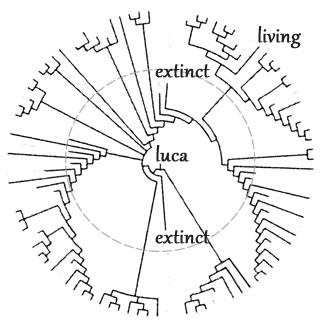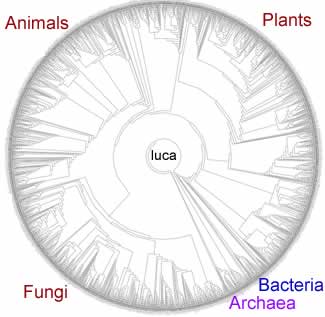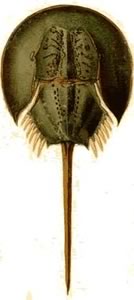| 4. Species:
what are they, where do they come from, where do they
go? |
|
A species is
a population of organisms that can, and
normally does, interbreed successfully with one another but not with
members of other populations (other species). |
 |
Over geological time, a species can have one of two fates -- it can continue, and occasionally divide so as to produce other species, or it can become extinct. |
 |
The idea of extinction is a relatively new one. In most non-scientific views of the world, the world was created largely as is – organisms do not become extinct nor do new types of organisms appear. Why would they? The creator does not presumably make mistakes. Fossils of various types were known for quite some time, but were originally thought to be either "jokes of nature" (lusus naturae) or represent animals that still lived some where on earth. This latter idea was plausible because much of the earth remained to be explored (at least by European scientists). It was easy to imagine that strange organisms lived elsewhere. |
With the European "voyages of discovery" from the 15th through the 18th centuries, the places where strange organisms could be hidden decreased drastically. It seemed more and more likely that extinction was real. George Cuvier (1769-1832) played a key role in establishing the science of paleontology and argued persuasively that past ages had seen organisms that were quite distinct from those now in existence. We now appreciate that the fossil record provides unambiguous evidence that, at different times in the past, quite different types of organisms existed. |
The most famous of these extinct organisms are the dinosaurs. Dinosaurs, and their extinct reptilian relatives, were found both on land and in the sea. Flying reptiles, pterosaurs and others, ranged in size from that of small modern birds to large airplanes. The ancestors of this family of tetrapod (four legged) vertebrates first appeared in the fossil record ~250 million years ago; they were a dominant form of life from ~230 to 65 million years ago. During the Ages of Dinosaurs (the Triassic – 248 to 206 million years ago, the Jurassic – 206 to 144 million years ago, and the Cretaceous –144 to 65 million years ago), there were many different species of dinosaurs, each characteristic of a particular age. |
Species of dinosaurs appeared and disappeared; what led to these changes? This leads to the broader question, why do species appear and disappear? Why does extinction happen? There are two general mechanisms. The first are more or less gradual responses to new and changing environments. |
For example, there is an on-going process of continental drift, which is largely responsible for earthquakes and volcanoes. About 200 million years ago, the supercontinent Pangaea broke up to form the continents we know today. This led to changes in climate and the physical isolation of many types of plants and animals. There have been other periods when the Earth appears to have been completely, or almost completely frozen over. |
One such snowball earth period may have been involved in the emergence of macroscopic multicellular life. Similarly, changes in atmospheric O2 likely caused a number of extinction and speciation events. Sometimes organisms that evolved on one continent get introduced into another, for example through the land bridge between Asia and the Americas. This can greatly perturb the species already present by introducing new pathogens, prey, and predators. There can also be more drastic and acute events that lead to essentially instant and unanticipated (and unanticipatable) environmental changes, such as massive meteorite impacts or sustained volcanic eruptions. There is evidence that such events are responsible for some observed mass extinctions. The most catastrophic of these extinction events was the Permian extinction (~245 million years ago), during which it appears that ~95% of marine organisms and ~75% of land species died off. The exact cause of the Permian extinction event remains unclear, but global cooling due in part to massive volcanic eruptions appears likely. |
It is widely held that the appearance of humans contributed to the extinction of various pleistocene megafauna which occurred ~8000-10,000 years ago [link]. In the event of changes, whether drastic or gradual, a species is faced with new challenges. |
Depending on how adapted a species has become to a particular ecological niche, even a minor change may leave it without the genetic resources (variation) needed for successful competition or adaptation. For example, consider these various Hawaiian finches →, some of which have become extremely specialized for feeding off specific types of flowers. As they specialize, they become better at extracting food from a particular flower type, and at the same time more dependent upon the continued existence of that flower type. |
Species formation: New species are the result of divergences between pre-existing populations. Once organisms have diverged to such an extent that they can no longer interbreed successfully, two (or more) species have emerged. How does speciation occur? The mechanism thought to drive most speciation is known as allopatric speciation. In allopatric speciation, a single population is divided into two or more physically separate populations. The size of the physical barrier involved clearly depends upon the organism. Some organisms have only a limited ability to move about; they interbreed only with organisms in their immediate neighborhood. |
If a species is spread over a large physical range, it may consist of many subpopulations that live in distinct environments and have varying levels of reproductive interactions with one another. Consider the black bear, Ursus americanus. Originally distributed across North America, the distribution is now much more fragmented. Isolated bear populations are free to adapt to their own particular environments. Clearly the environment in Florida is different from that in Mexico, Alaska or Newfoundland. Different environments are likely to favor different adaptations. If, over time, these populations were to come back into contact with one another, they may or may not be able to interbreed successfully. |
If they are reproductively isolated, two (or even more) species will have been formed. This bifurcating process, taking place over tens to hundreds of millions of years, has produced many different species [link to Tree of Life]. This pdf (clink on it to open it, watch
out, it is big!), generated by David Hillis The outer circumference
of the circle represents those organisms alive today. As one heads
to the center of the circle, one goes back in time. |
 |
Reproductive isolation: There are a number of adaptations that can lead to, and reinforce reproductive isolation. These range from differences in responses to various queues (visual, sounds, smells and behaviors) associated with mating, different behaviors (mating in the morning or the evening, or different times of the year), to physically incompatible genitalia or gametes. |
Over time two daughter species may be "reunited", but be unable to interbreed - reproductive isolation has occurred; one species has become two. A second type of speciation is known as sympatric speciation, is more controversial. It involves a single population of organisms that splits into two reproductively isolated communities. The problem with sympatric speciation has been, what stops organisms of the two nascent species from interbreeding - how are these populations isolated so that different traits can emerge? Recently a number of plausible mechanisms have been identified. One involves sexual selection [video link] while another involves host selection. For example, consider the role of song in the mating habits of birds. If specializations in beak shape occur and facilitate feeding on specific food sources (as with the Hawaiian finches above, or the more famous example of Darwin's finches of the Galapagos [link][link]), these can (and have been shown to) alter the bird's song [link], which can change who mates with whom. |
In host selection, animals (such as insects) that feed off specific hosts may reproduce in distinct zones associated with their hosts. In a process very much like allopatric specification, this can lead to differential adaptation, divergence and eventual reproductive isolation, that is, speciation. Most species exist for relatively short periods of time, measured in millions of years, and leave no descendants among organisms alive today. A few species are the ancestors of many (most) current species. Some species have persisted, superficially unchanged, for long periods of time. These are sometimes referred to as living fossils. |
|
 |
Questions
to answer |
|
Questions
to ponder |
|
| replace with revised beSocratic activity |
Tweet
revised
10-May-2014
|